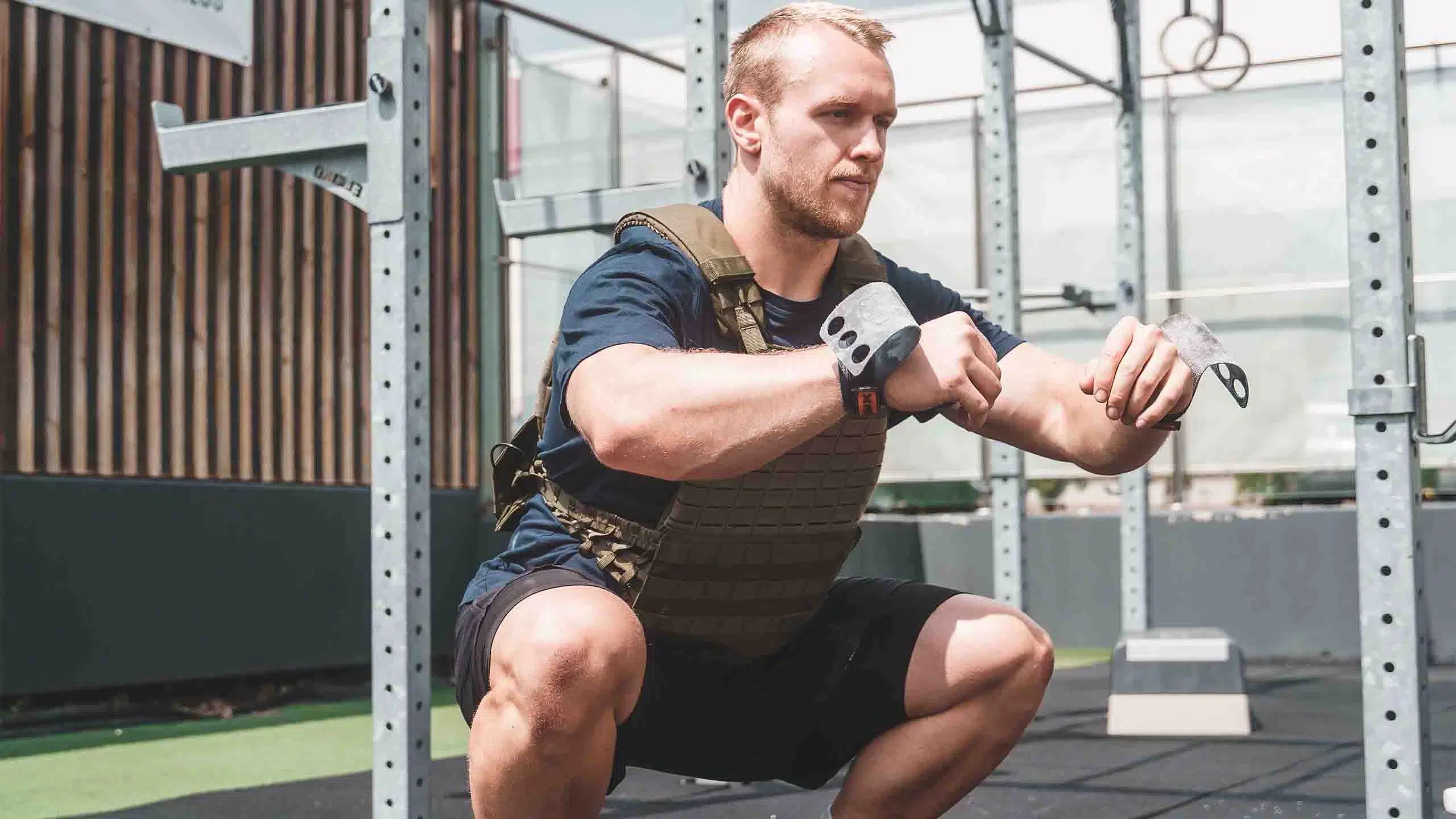

Featured
What Is Murph Workout
Modified: August 21, 2023
Discover the intense training routine known as the Murph Workout. Featured in fitness circles, this challenging workout combines running, pull-ups, push-ups, and squats for a total body transformation.
Overview
The Murph workout is a challenging and intense fitness routine that has gained immense popularity in recent years. Named after Lieutenant Michael P. Murphy, a Navy SEAL who made the ultimate sacrifice in Afghanistan, the workout is a tribute to his bravery and selflessness. It has become a symbol of honor and determination for fitness enthusiasts around the world.
The Murph workout consists of a combination of exercises designed to test your strength, endurance, and mental resilience. It is commonly performed on Memorial Day in the United States to commemorate fallen heroes, but it can be done any time of the year to push your limits and challenge yourself.
This grueling workout includes a one-mile run, followed by 100 pull-ups, 200 push-ups, and 300 air squats, and finishes with another one-mile run. As if that wasn’t challenging enough, there’s an option to wear a weighted vest during the workout to add an extra level of difficulty.
The Murph workout is a popular choice among CrossFit athletes and military personnel, but it is suitable for anyone looking to push their physical and mental boundaries. It offers a comprehensive full-body workout that targets multiple muscle groups and improves cardiovascular endurance.
While the Murph workout may seem daunting at first, it can be modified to suit different fitness levels and abilities. This allows individuals of all levels to participate and reap the benefits of this intense workout. Whether you’re a seasoned athlete or a beginner, the Murph workout offers a scalable challenge that can be tailored to your fitness goals.
In the following sections, we’ll delve into the history of the Murph workout, its components, how to perform it, scaling options, benefits, challenges, and safety measures. So, lace up your shoes, brace yourself for the burn, and let’s dive into the world of the Murph workout.
History
The origins of the Murph workout can be traced back to Lieutenant Michael P. Murphy, a remarkable individual who served as a Navy SEAL. Lieutenant Murphy was tragically killed in action during Operation Red Wings in Afghanistan on June 28, 2005. To honor his memory and recognize his courage, the Murph workout was created.
Lieutenant Murphy had a deep passion for fitness and would often push his physical limits through grueling workouts. One of his favorite routines was a challenging combination of exercises that eventually became known as the Murph workout.
After his passing, friends and fellow servicemen began performing this workout to honor Lieutenant Murphy’s memory and pay tribute to his sacrifice. Over time, the workout gained popularity and became synonymous with his legacy.
The Murph workout became more widely recognized when it was featured in the 2014 movie “Lone Survivor,” which depicted the events of Operation Red Wings. In the film, actor Mark Wahlberg portrayed Lieutenant Murphy and demonstrated the difficulty and intensity of this workout.
Since then, the Murph workout has become a staple in the fitness world, particularly in CrossFit communities and among military personnel. It is commonly performed on Memorial Day in the United States, a day dedicated to honoring and remembering fallen soldiers.
The Murph workout serves as a physical and mental reminder of the sacrifices made by Lieutenant Murphy and countless others who have given their lives in service to their country. It has become a symbol of dedication, resilience, and the indomitable spirit of the human body and mind.
Today, the Murph workout continues to inspire people of all fitness levels to push beyond their limits and test their physical and mental fortitude. It serves as a tribute to the heroes who have sacrificed everything and a reminder of the importance of honoring their memory.
Components
The Murph workout consists of several challenging exercises that collectively target different muscle groups and test your endurance. The components of the Murph workout are as follows:
1. One-Mile Run: The workout begins and ends with a one-mile run. This serves as a warm-up and cool-down, while also adding an additional cardiovascular challenge to the routine.
2. Pull-Ups: Following the run, you move onto 100 pull-ups. These target your upper body, primarily the muscles in your back, shoulders, and arms. You can perform strict pull-ups, kipping pull-ups, or use resistance bands to assist if needed.
3. Push-Ups: After completing the pull-ups, you transition to 200 push-ups. This exercise primarily targets your chest, triceps, and shoulders. You can choose to perform full push-ups or modified versions, such as knee push-ups, to suit your fitness level.
4. Air Squats: Once the push-ups are done, you move on to 300 air squats. This lower-body exercise targets your quadriceps, hamstrings, and glutes. Keep your feet shoulder-width apart and maintain proper form throughout the movement.
5. One-Mile Run: After the air squats, you finish the workout with another one-mile run. This final run tests your cardiovascular endurance and serves as a challenging end to the workout.
It’s important to note that there is also an option to perform the Murph workout with a weighted vest, adding an extra level of difficulty to each exercise.
The combination of running, pull-ups, push-ups, and air squats in the Murph workout targets both upper body and lower body muscles, providing a comprehensive full-body workout. It challenges your cardiovascular fitness, muscular strength, and endurance, pushing you to reach your limits and improve your overall physical fitness.
As you progress through the different components of the Murph workout, you’ll not only build strength and endurance but also test your mental resilience and inner determination. It is a challenging workout that requires discipline, focus, and a never-give-up attitude.
How to Perform the Murph Workout
The Murph workout is a demanding routine that requires proper technique and pacing to maximize your performance. Here’s a step-by-step guide on how to perform the Murph workout:
Step 1: Warm-up: Begin with a dynamic warm-up to prepare your body for the intense workout ahead. This can include light jogging, dynamic stretches, and mobility exercises to loosen up your muscles and joints.
Step 2: One-Mile Run: Start the workout with a one-mile run to elevate your heart rate and warm up your muscles further. Pace yourself, as this is just the beginning of the challenging routine.
Step 3: Pull-Ups: Immediately after the run, move on to 100 pull-ups. Choose a grip that you are comfortable with, whether it’s an overhand grip, underhand grip, or a combination of both. Break the reps into sets if needed, focusing on maintaining proper form throughout.
Step 4: Push-Ups: Following the pull-ups, proceed to 200 push-ups. Keep your body in a straight line from head to toe and maintain a controlled motion as you lower your chest towards the ground and push back up. Modify the exercise if necessary by performing knee push-ups or using an elevated surface.
Step 5: Air Squats: Once the push-ups are completed, move on to 300 air squats. Stand with your feet shoulder-width apart and squat down, keeping your weight on your heels and your chest up. Go as low as you comfortably can and rise back up to complete one rep.
Step 6: One-Mile Run: Finish the workout with another one-mile run. Push yourself to maintain a steady pace, even when fatigued, and challenge yourself to complete the run in a similar time to your initial mile.
Remember to listen to your body throughout the workout. Pace yourself and take breaks as needed, but try to keep them to a minimum to maintain the intensity of the workout. It’s important to prioritize proper form and technique over speed to avoid injury.
As with any intense workout, it’s important to cool down properly after completing the Murph workout. Incorporate gentle stretches and mobility exercises to help reduce muscle soreness and aid in recovery.
While the Murph workout can be challenging, it is also highly customizable. Don’t be afraid to scale the workout to your fitness level by reducing the number of repetitions, modifying exercises, or breaking up the work into smaller sets. The goal is to push yourself while maintaining proper form and safety.
Scaling and Modifications
The Murph workout is known for its challenging nature, but it can be modified and scaled to accommodate different fitness levels and abilities. Here are some options for scaling and modifications:
Reduced Repetitions: One way to scale the Murph workout is to reduce the number of repetitions for each exercise. For example, instead of 100 pull-ups, you can start with 50 or use a resistance band for assistance. Similarly, you can decrease the number of push-ups and air squats to make the workout more manageable.
Modified Push-Ups: If performing traditional push-ups is challenging, you can modify the movement by doing knee push-ups or using an elevated surface, such as a bench or box, to decrease the intensity. This allows you to maintain proper form and gradually build strength.
Assisted Pull-Ups: If you’re unable to do full pull-ups, you can use resistance bands or an assisted pull-up machine to provide assistance. This helps to gradually develop the necessary strength to perform strict pull-ups over time.
Interval Training: If completing the one-mile runs continuously is too demanding, you can opt for interval training. Break the runs into shorter distances and take brief breaks in between to recover. This can help maintain a consistent pace throughout the workout.
Weighted Vest: For those seeking an extra challenge, you can choose to wear a weighted vest during the workout. This increases the resistance and intensity of each exercise, making it more demanding on your muscles and cardiovascular system.
Partner or Team Murph: Another option is to perform the Murph workout as a team or with a partner. This allows you to share the workload and provide support and encouragement to each other throughout the workout. It can be a great way to build camaraderie and push each other to new heights.
Remember, the goal of scaling and modifications is to make the workout challenging yet achievable for your current fitness level. Gradually increase the intensity and volume as you become stronger and more comfortable with the movements.
Consult with a fitness professional if you’re uncertain about the appropriate scaling options for your specific needs. They can provide guidance and help tailor the workout to your individual goals and abilities.
Benefits of the Murph Workout
The Murph workout offers a wide range of physical and mental benefits. Here are some key advantages of incorporating the Murph workout into your fitness routine:
1. Full-Body Workout: The combination of running, pull-ups, push-ups, and air squats targets multiple muscle groups, providing a comprehensive full-body workout. It helps to improve strength, endurance, and overall muscular development.
2. Improved Cardiovascular Fitness: The continuous running intervals in the Murph workout elevate your heart rate, improving cardiovascular endurance and stamina. This translates to greater efficiency in daily activities, sports, and other physical pursuits.
3. Mental Resilience: The Murph workout challenges not only your physical strength but also your mental toughness. Pushing through the demanding exercises and persevering when fatigued helps to build mental resilience, discipline, and determination.
4. Increased Strength and Muscle Definition: Pull-ups and push-ups engage the upper body muscles, including the back, chest, shoulders, and arms. Air squats target the lower body, particularly the quadriceps, hamstrings, and glutes, leading to increased strength and muscle definition.
5. Enhanced Core Stability: The various exercises performed in the Murph workout require core stability and engagement. The result is improved core strength and stability, which contributes to better posture and overall functional fitness.
6. Weight Management: The high intensity and calorie-burning nature of the Murph workout make it an effective option for weight management. It helps to burn calories and boost metabolism, contributing to weight loss and overall body composition improvement.
7. Goal Setting and Achievement: Setting goals and working towards completing the Murph workout can provide a sense of accomplishment and motivation. As you progress and achieve milestones, it can boost self-confidence and inspire you to take on new challenges.
8. Commemoration and Connection: The Murph workout serves as a meaningful way to honor the sacrifices of military personnel and fallen heroes. Participating in the workout on Memorial Day or any other occasion fosters a sense of connection and community with others who share a similar appreciation for the significance of the workout.
9. Versatility and Customization: The Murph workout is highly versatile and can be modified to suit different fitness levels and abilities. Whether you’re a beginner or an advanced athlete, the routine can be tailored to meet your specific goals and challenges.
By incorporating the Murph workout into your fitness routine, you can experience these benefits and more. Remember to listen to your body, modify exercises as needed, and gradually progress to improve your overall fitness and well-being.
Common Challenges and Tips
The Murph workout presents several challenges that individuals may encounter during their training. Understanding and preparing for these challenges can help you overcome them and maximize your performance. Here are some common challenges and tips to help you tackle them:
1. Fatigue: Fatigue is a common challenge, particularly during high-volume exercise like the Murph workout. Pace yourself and listen to your body. Take short breaks if needed, but try to keep them minimal to maintain the intensity of the workout. Focus on proper breathing techniques to optimize your energy levels throughout.
2. Pull-Up Endurance: Pull-ups can be physically demanding, especially when performing a large number of repetitions. To build pull-up endurance, practice regularly with progressive overload. Incorporate exercises that target the muscles used in pull-ups, such as lat pulldowns and assisted pull-ups, to strengthen those muscle groups.
3. Push-Up Form: Maintaining proper form during push-ups can be challenging, especially as fatigue sets in. Keep your body in a straight line, engage your core, and lower your chest towards the ground while keeping your elbows close to your body. If form starts to deteriorate, modify the push-up style or take a brief break to reset your form.
4. Mental Stamina: The Murph workout tests your mental resilience. Stay focused and determined. Break down the workout into manageable chunks, setting small milestones for yourself. Visualize yourself completing each exercise and stay positive throughout the workout.
5. Lower Body Endurance: The high volume of air squats challenges lower body endurance. Strengthen your lower body muscles through regular squats, lunges, and other lower body exercises. Gradually increase your repetitions and weights to build endurance over time.
6. Hydration and Nutrition: Proper hydration and nutrition are key to performing at your best. Ensure you are adequately hydrated before, during, and after the workout. Consume a balanced meal or snack containing carbohydrates, protein, and healthy fats at least an hour before the workout to provide sustained energy.
7. Gradual Progression: The Murph workout is challenging, and it’s important to progress gradually. Start with modified versions of the exercises and gradually increase the intensity as you get stronger. Be patient and celebrate small improvements along the way.
8. Recovery and Rest: Allow your body time to recover between Murph workouts. Incorporate rest days into your training routine to prevent overtraining and reduce the risk of injury. Proper rest and recovery are essential for muscle repair and growth.
Remember, everyone’s journey with the Murph workout will be different. Listen to your body, be patient with yourself, and recognize that progress takes time. With consistency, determination, and the right mindset, you can overcome these challenges and achieve new heights in your fitness journey.
Precautions and Safety Measures
The Murph workout is a demanding workout that requires proper preparation and attention to safety. Here are some precautions and safety measures to consider before undertaking the Murph workout:
1. Consult a Healthcare Professional: If you have any pre-existing medical conditions or concerns, it’s important to consult with a healthcare professional before attempting the Murph workout or any intense exercise routine.
2. Progress Gradually: The Murph workout is challenging, especially for beginners. Start with scaled versions of the exercises and gradually increase the intensity and volume as your fitness level improves. Rushing into the workout without proper preparation can increase the risk of injury.
3. Warm-Up and Cool-Down: Always begin your workout with a proper warm-up to prepare your muscles and joints for the intense exercise. Incorporate dynamic stretches and mobility exercises. Similarly, cool down with static stretches and gentle movements to aid in muscle recovery.
4. Maintain Proper Form: Correct form is crucial for preventing injury during the Murph workout. Follow proper technique for each exercise, including maintaining a neutral spine, engaging your core, and avoiding excessive joint stress. Seek guidance from a qualified fitness professional if you’re unsure about proper form.
5. Gradually Introduce Weighted Vest: If you choose to use a weighted vest, introduce it gradually. Start with a lighter weight and gradually increase the load as your body adapts. Ensure the vest fits securely and does not restrict your movement or breathing.
6. Stay Hydrated: Hydration is essential during any intense workout. Drink plenty of water before, during, and after the workout to prevent dehydration. Listen to your body’s thirst cues and replenish fluids accordingly.
7. Listen to Your Body: Pay attention to how your body feels during the workout. If you experience severe pain, dizziness, or shortness of breath, stop immediately and seek medical attention if necessary. Push yourself, but not at the expense of your safety.
8. Recovery and Rest: Allow your body ample time to recover between Murph workouts. Adequate rest and recovery are essential for muscle repair and growth. Overtraining can lead to exhaustion, increased risk of injury, and decreased performance.
9. Modify as Needed: Don’t hesitate to modify the Murph workout based on your capabilities and limitations. Adjust the repetitions, use assistance (bands or partner support) for pull-ups, or modify exercises to suit your fitness level and reduce the risk of injury.
Remember, safety should always be a priority during any exercise routine. It’s important to know your limits, listen to your body, and scale the workout accordingly. By following these precautions and safety measures, you can minimize the risk of injury and create a safe and effective training environment.
Sample Murph Workout Variations
The Murph workout is highly customizable, allowing for variations to suit different fitness levels, goals, and equipment availability. Here are some sample Murph workout variations:
1. Half Murph: If the full Murph workout seems too challenging, you can start with a half Murph. Perform a 0.5-mile run, followed by 50 pull-ups, 100 push-ups, 150 air squats, and finish with another 0.5-mile run. This variation reduces the volume of each exercise while still providing a challenging workout.
2. Mini Murph: For beginners or those with time constraints, a mini Murph workout is a great option. Perform a 0.25-mile run, followed by 25 pull-ups, 50 push-ups, 75 air squats, and finish with another 0.25-mile run. This allows you to experience the essence of the Murph workout in a shorter amount of time.
3. Partner Murph: Team up with a partner and divide the work between you. One person runs while the other performs the exercises, and then switch. This variation promotes teamwork and provides the opportunity to push each other through the workout.
4. Weighted Murph: Challenge yourself by adding a weighted vest during the entire workout. Start with a manageable weight and gradually increase it as you become more comfortable. The additional weight increases the intensity and resistance, adding a new level of difficulty to each exercise.
5. Strict Murph: Perform strict pull-ups without using any kipping or momentum. This variation focuses on strict strength and control, challenging your muscles in a different way. If strict pull-ups are too challenging, use resistance bands or a seated row machine as an alternative.
6. Sandbag Murph: Replace the weighted vest with a sandbag for added resistance. Hold the sandbag during the run and incorporate it into the pull-ups, push-ups, and air squats. The uneven weight distribution of the sandbag adds an extra challenge to the workout.
7. Murph EMOM: Perform an “every minute on the minute” (EMOM) Murph workout. Start a timer and complete a set number of pull-ups, push-ups, and air squats within a minute, then rest for the remaining time. Repeat this pattern for the entire workout. This variation adds a time constraint, challenging your speed and agility.
These are just a few examples of how you can modify the Murph workout to suit your preferences and fitness level. Feel free to customize the workout based on your capabilities, available equipment, and goals. Remember, the goal is to challenge yourself while maintaining proper form and safety throughout the workout.
Conclusion
The Murph workout is a challenging and intense fitness routine that encompasses running, pull-ups, push-ups, and air squats. It is a tribute to Lieutenant Michael P. Murphy and serves as a symbol of honor and determination. Whether you choose to perform it on Memorial Day or any other day of the year, the Murph workout pushes your physical and mental limits.
Throughout this article, we’ve explored the history, components, and variations of the Murph workout. We’ve discussed the importance of scaling and modifications to tailor the workout to individual fitness levels and goals. Additionally, we’ve highlighted the numerous benefits of incorporating the Murph workout into your fitness routine, ranging from improved strength and endurance to increased mental resilience.
However, it is crucial to approach the Murph workout with caution and prioritize safety. Ensure you warm up properly, maintain proper form during exercises, and listen to your body’s cues. By following these precautions and safety measures, you can minimize the risk of injury and optimize your performance.
Remember, the Murph workout is adaptable and can be modified to suit your needs. Whether you’re a beginner just starting your fitness journey or an experienced athlete looking for a new challenge, there’s a version of the Murph workout that can push you to new heights.
Now that you have a thorough understanding of the Murph workout, its history, components, variations, and precautions, it’s time to lace up your shoes, gather your determination, and take on this remarkable workout. Embrace the physical and mental challenges it presents, and watch as you progress and grow stronger with each rep, run, and set.
So, are you ready to push your limits and honor the legacy of Lieutenant Michael P. Murphy? Take on the Murph workout and embark on a journey of strength, endurance, and personal growth.






